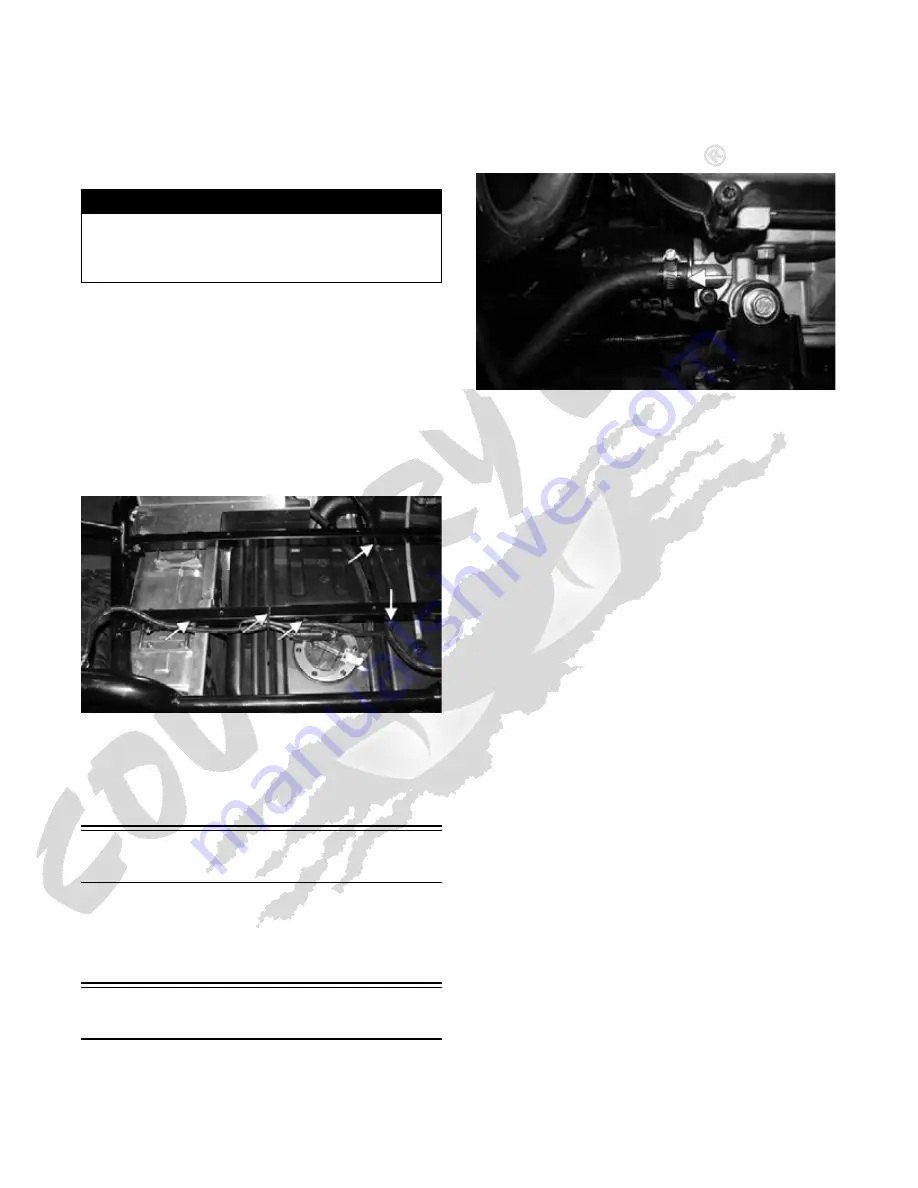
122
6. Remove the cargo box supports and the heat shield;
then wrap a shop cloth around the gas line connector
to catch any fuel spray and disconnect from the fuel
pump.
7. Remove the gas tank hold-down bracket and remove
the gas tank.
INSTALLING
1. Place the gas tank into position on the cradle and
secure with the hold-down bracket. Tighten the fasten-
ers until the bracket is snug on the tank but not distort-
ing it.
2. Place the heat shield into position; then install the
cargo box supports and start but do not tighten all fas-
teners. After all fasteners are started, tighten securely.
3. Press the wiring harness anchors into the proper loca-
tions on the cargo supports and secure nylon ties
where removed; then connect tail/brakelight connec-
tors and fuel pump//fuel level connector.
WC179B
4. Install the muffler and secure with the four springs.
5. Install the cargo box; then install the rear body panel.
6. Connect the negative battery cable and install the bat-
tery cover; then set the seats in and lock into position.
Gas/Vent Hoses
Replace the gas hose every two years. Damage from aging
may not always be visible. Do not bend or obstruct the
routing of the vent hoses. Make certain the vent hoses are
securely connected and the opposite ends are always open.
Oil Filter/Oil Pump
NOTE: Whenever internal engine components wear
excessively or break and whenever oil is contami-
nated, the oil pump should be replaced.
TESTING OIL PUMP PRESSURE
NOTE: The engine must be warmed up to operating
temperature (cooling fan cycling) for this test.
1. Remove the oil hose from the fitting nearest the oil fil-
ter base.
WC222A
2. Using a suitable “T” fitting, connect Oil Pressure Test Kit
to the oil fitting and hose. Tighten all clamps securely.
NOTE: Some oil seepage may occur when installing the
oil pressure gauge. Wipe up oil residue with a cloth.
3. Place the transmission in park and start the engine.
Allow the engine to warm up to operating temperature
(with cooling fans cycling).
4. Set the speedometer/tachometer to RPM. With the
engine running at 3000 RPM, the pressure gauge must
show 1.05-1.2 kg/cm
2
(15-17 psi).
5. Remove the test kit from the vehicle and install the oil
hose. Tighten the clamps securely.
NOTE: If oil pressure is lower than specified, check
for an oil leak, clogged oil filter, or defective oil pump.
NOTE: If oil pressure is higher than specified, check
for too heavy engine oil weight (see General Informa-
tion), clogged oil passage, or improper installation or
type of the oil filter.
REMOVING/DISASSEMBLING
1. Remove the oil pump from the engine (see Center
Crankcase Components in Engine/Transmission).
2. Remove oil pump components from crankcase.
CLEANING AND INSPECTING
1. Clean all oil-pump components.
2. Inspect the rotors for scoring and gouges.
3. Inspect the driveshaft and driven sprocket for damage.
4. Inspect the crankcase for scoring, cracks, or damage.
ASSEMBLING/INSTALLING
1. Place the rotors into the crankcase making sure the
dowel pin is in the groove of the rotor.
2. Place the cover onto the crankcase.
3. Secure the pump with the two cap screws coated with
blue Loctite #243. Tighten to 8 ft-lb.
! WARNING
Whenever any maintenance or inspection is made on
the fuel system during which there may be fuel leakage,
there should be no welding, smoking, open flames, etc.,
in the area.
















































